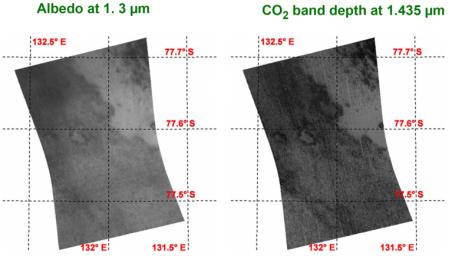
|
South Polar Cryptic Terrain in Early Spring
- Click the image above for a larger view
- Full-Res JPEG (1203 x 680) (91.1 kB)
- Full-Res TIFF (1203 x 680) (2.5 MB)
Caption:
This image of the south polar region of Mars was taken by the Compact Reconnaissance Imaging Spectrometer for Mars (CRISM) at 1557 UTC (10:57 a.m. EST) on Feb. 10, 2007, near 77.55 degrees south latitude, 131.98 degrees east longitude. CRISM's image was taken in 544 colors covering 0.36-3.92 micrometers, and shows features as small as 30 meters (98 feet) across. The region covered is just over 9 kilometers (5.6 miles) wide at its narrowest point, and is one of several in which CRISM is monitoring the evaporation (or "sublimation") of the seasonal frost cap.
The Martian south polar seasonal cap consists of carbon dioxide ice and frost, whose sublimation in the Martian spring creates a variety of features unlike anything in Earth's circumpolar regions. Part of the cap known as the "cryptic region" is so cold that it must be covered with carbon dioxide frost, but it is also unexpectedly low in brightness and exhibits a variety of unusual dark blotches. Many scientists believe that carbon dioxide gas trapped below the sublimating ice is released in bursts, which carry along dust that gradually darkens the ice. One idea is that geyser-like dust eruptions form the dark blotches, and that the blotches grow, coalesce, and eventually hide the frost under a thin layer of dust.
This image was taken shortly after sunrise with the Sun only about five degrees above the horizon. The left version shows brightness of the surface at 1.3 micrometers. The right version shows strength of an absorption band due to carbon dioxide frost at 1.435 micrometers; brighter areas have a stronger absorption and more carbon dioxide frost. However, even the darkest areas still have frost. The correlation between brightness and carbon dioxide frost abundance is striking, supporting the idea that the frost is being darkened by dust. Frost in the upper right corner shows the expected dark blotches, whereas the frost over the rest of the image is more uniformly dark, hinting that another darkening process may be at work.
Background Info:
CRISM's mission: Find the spectral fingerprints of aqueous and hydrothermal deposits and map the geology, composition and stratigraphy of surface features. The instrument will also watch the seasonal variations in Martian dust and ice aerosols, and water content in surface materials -- leading to new understanding of the climate.
The Compact Reconnaissance Imaging Spectrometer for Mars (CRISM) is one of six science instruments on NASA's Mars Reconnaissance Orbiter. Led by The Johns Hopkins University Applied Physics Laboratory, the CRISM team includes expertise from universities, government agencies and small businesses in the United States and abroad.
Cataloging Keywords:
| Name | Value | Additional Values |
|---|---|---|
| Target | Mars | |
| System | ||
| Target Type | Planet | |
| Mission | Mars Reconnaissance Orbiter (MRO) | |
| Instrument Host | Mars Reconnaissance Orbiter | |
| Host Type | Orbiter | |
| Instrument | Compact Reconnaissance Imaging Spectrometer for Mars (CRISM) | |
| Detector | ||
| Extra Keywords | Color, Dust, Map, Thermal, Water | |
| Acquisition Date | ||
| Release Date | 2007-03-16 | |
| Date in Caption | 2007-02-10 | |
| Image Credit | NASA/JPL/JHUAPL/IAS | |
| Source | photojournal.jpl.nasa.gov/catalog/PIA09350 | |
| Identifier | PIA09350 | |
